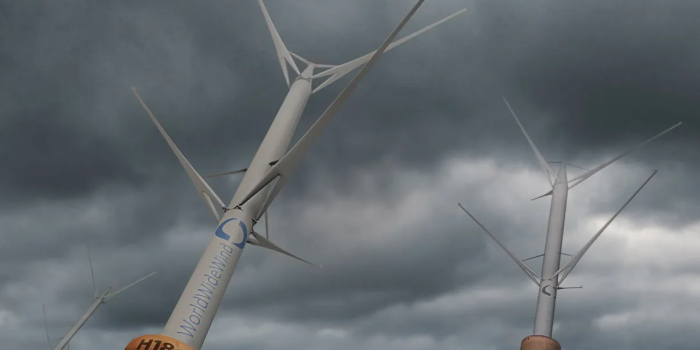In the ever-evolving realm of renewable energy, a wind of change is blowing offshore as Norwegian startup World Wide Wind (WWW) introduces an audacious wind turbine design set to be tested in Norway.
Aptly termed “counter-rotating vertical-axis turbines,” this innovation carries the potential to transform offshore wind energy, offering heightened efficiency, reduced costs, and the promise of doubling energy generation at sea. This groundbreaking concept rests on three pillars of innovation. Firstly, the turbine design takes to the water, discarding the need for structures anchored in the seafloor. This floating technology enables installations in deeper waters, unlocking additional wind resources, and addresses concerns about visual interference, often associated with traditional wind farms.
Secondly, a departure from the conventional horizontal-axis configuration sees the turbine blades elegantly pivoting on a vertical axis. This distinctive orientation, reminiscent of an inverted stand mixer, sets this design apart, exploring the potential of vertical-axis floating wind technology.

The pièce de résistance is the integration of a counter-rotating turbine and blades on the same axis, but with a twist—literally, as they rotate in the opposite direction. This ingenious addition tackles several challenges, including the strategic placement of heavy, high-maintenance hardware near the base or underwater. Unlike their top-heavy horizontal-axis counterparts, these turbines can reach greater heights, accommodating larger blades—a pivotal factor in optimizing wind energy production.
With a tilting vertical axis and strategic blade configuration, the turbine adeptly captures wind from multiple directions, mitigating turbulence in its wake. This capability allows for a more compact arrangement of turbines within a wind farm, enhancing overall efficiency.
Notably, the counter-rotating turbines neutralize torque on the system, a common drawback of vertical-axis turbines. The resultant double rotation not only provides a passive tilting mechanism, optimizing the turbine’s angle based on wind direction but also holds the potential to increase power generation significantly.

Trond Lutdal, former CEO of WWW, underscores the potential advantages, stating, “It’s lower cost, it’s much more scalable, and any maintenance happens at the bottom and not hundreds of feet up in the air.” The initial test prototype, standing at 62 feet tall with a 30-kilowatt capacity, is a precursor to grander aspirations. WWW envisions scaling up to a towering 1,312 feet with a 40-megawatt capacity, nearly double that of current large-scale wind turbines.
A larger 1.5-megawatt prototype is anticipated to undergo testing in 2025. This prototype aims to pave the way for a commercially available 24-megawatt version by 2030—surpassing the capacity of existing offshore turbines.
As this visionary wind turbine design progresses through testing and development, it holds the potential to reshape offshore wind energy production and usher in a cleaner, more sustainable era.


